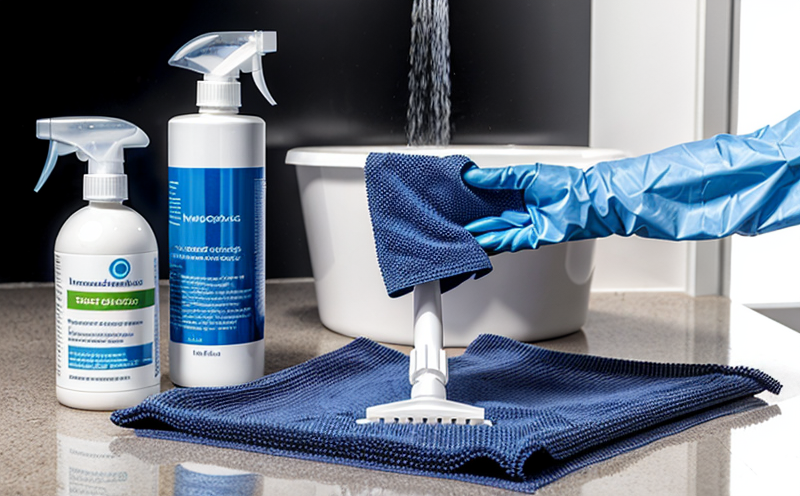Nanomaterials in Cleaning & Hygiene Products Testing
The integration of nanomaterials into cleaning and hygiene products has revolutionized the way we approach sanitation and personal care. Nanotechnology, with its ability to manipulate materials at a molecular scale, offers unique properties that enhance product performance, efficacy, and sustainability. This section provides an in-depth look at the testing procedures required for nanomaterials used in these sectors.
The primary focus is on ensuring that products containing nanomaterials meet stringent safety, effectiveness, and regulatory compliance standards. The challenges of nanotechnology lie in its unique properties, which can differ significantly from those of macro-scale materials. Therefore, comprehensive testing is essential to ensure the safe and effective use of these materials.
Nanomaterials used in cleaning and hygiene products include silver nanoparticles for antibacterial effects, titanium dioxide for UV protection, and zinc oxide for sunscreens. These materials can be engineered to have enhanced properties such as higher reactivity or increased surface area, which are crucial for their intended applications. However, these same attributes also necessitate careful evaluation to ensure they do not pose risks.
Testing nanomaterials in cleaning and hygiene products involves a multidisciplinary approach that combines chemistry, toxicology, and materials science. The goal is to assess the physical, chemical, and biological properties of nanomaterials while considering their potential environmental impact and human health effects. This section will delve into the specific tests conducted and the regulatory standards against which these tests are performed.
| Standard | Description |
|---|---|
| ISO 17253-1:2015 | Safety of Nanomaterials – Part 1: Characterization and Testing |
| ASTM E2929-14 | Standard Practice for Reporting the Presence or Absence of Nanoparticles in Materials |
| EN 16310:2015 | Safety of Nanomaterials – Part 1: Characterization and Testing |
The above standards provide a framework for the characterization, testing, and reporting of nanomaterials. They ensure that all tests are conducted in a consistent manner, allowing for reliable comparison between different products.
- Physical Testing: This includes size distribution, shape, and morphology analysis to determine if the nanomaterial meets the required specifications.
- Chemical Testing: The chemical composition of the nanomaterial is analyzed to ensure it contains only approved compounds.
- Toxicological Testing: Toxicity studies are conducted to assess potential adverse effects on human health and the environment. These tests may include in vitro and in vivo evaluations, depending on the risk assessment.
- Environmental Impact Assessment: The environmental impact of nanomaterials is evaluated through life cycle assessments (LCAs) to determine their overall sustainability.
The testing process is rigorous and involves multiple stages. Specimen preparation plays a crucial role in ensuring accurate results. This includes dispersing the nanomaterial into a suitable medium, such as water or air, depending on the intended application of the product. The specimen must be prepared in a way that mimics real-world conditions to ensure reliable test outcomes.
Instrumentation used in testing nanomaterials is highly specialized and includes advanced electron microscopy, spectroscopy techniques, and particle sizing instruments. These tools provide precise measurements of the nanomaterial's properties, which are essential for compliance with regulatory requirements.
The results of these tests are then reported in a manner that is both detailed and accessible to all stakeholders involved in product development and regulation. This includes quality managers, compliance officers, R&D engineers, and procurement teams who need to understand the implications of using nanomaterials in their products.
Applied Standards
| Standard | Description |
|---|---|
| ISO 17253-1:2015 | Safety of Nanomaterials – Part 1: Characterization and Testing |
| ASTM E2929-14 | Standard Practice for Reporting the Presence or Absence of Nanoparticles in Materials |
| EN 16310:2015 | Safety of Nanomaterials – Part 1: Characterization and Testing |
The standards mentioned above are critical for ensuring that nanomaterials used in cleaning and hygiene products meet the highest safety and efficacy standards. Compliance with these standards is essential to protect public health and ensure environmental sustainability.
Benefits
- Enhanced Performance: Nanomaterials offer improved performance in cleaning and hygiene products, such as increased effectiveness against bacteria and viruses.
- Safety Assurance: Rigorous testing ensures that nanomaterials do not pose risks to human health or the environment.
- Regulatory Compliance: Adherence to international standards guarantees compliance with local regulations.
- Economic Efficiency: By using advanced materials, manufacturers can create products that are more cost-effective and long-lasting.
- Innovation: Nanotechnology opens up new possibilities for product development and innovation in the cleaning and hygiene sectors.
The use of nanomaterials in cleaning and hygiene products brings numerous benefits to both manufacturers and consumers. These materials enhance performance, ensure safety, and promote compliance with regulatory standards. Additionally, they contribute to economic efficiency and drive innovation within the industry.
Competitive Advantage and Market Impact
The inclusion of nanomaterials in cleaning and hygiene products provides a significant competitive advantage by offering superior performance and safety. Consumers are increasingly seeking eco-friendly, effective, and safe products. By incorporating nanotechnology into their offerings, companies can differentiate themselves from competitors and appeal to environmentally conscious consumers.
Moreover, regulatory compliance is becoming more stringent, with increasing emphasis on sustainability and safety. Companies that demonstrate a commitment to these values through rigorous testing and adherence to international standards are likely to gain market share. The use of nanomaterials also opens up new opportunities for innovation, allowing companies to introduce cutting-edge products that meet the evolving needs of consumers.
The market impact of nanomaterials in cleaning and hygiene products is substantial. As more countries adopt stricter regulations on the use of these materials, manufacturers must adapt to ensure compliance. This adaptation can drive technological advancements and lead to the development of new products with enhanced properties. The demand for safe and effective cleaning solutions will continue to grow, making the integration of nanotechnology an essential strategy for market success.





